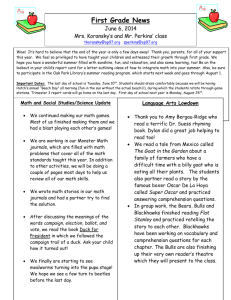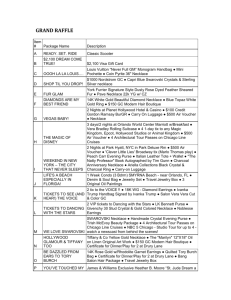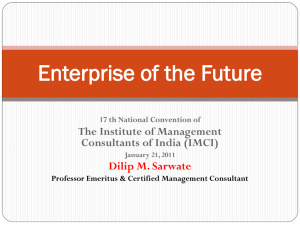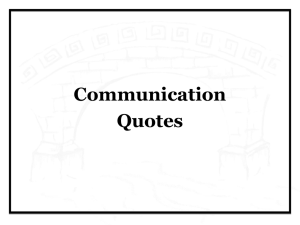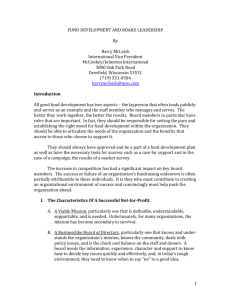Final Paper Chicago Blackhawks
advertisement
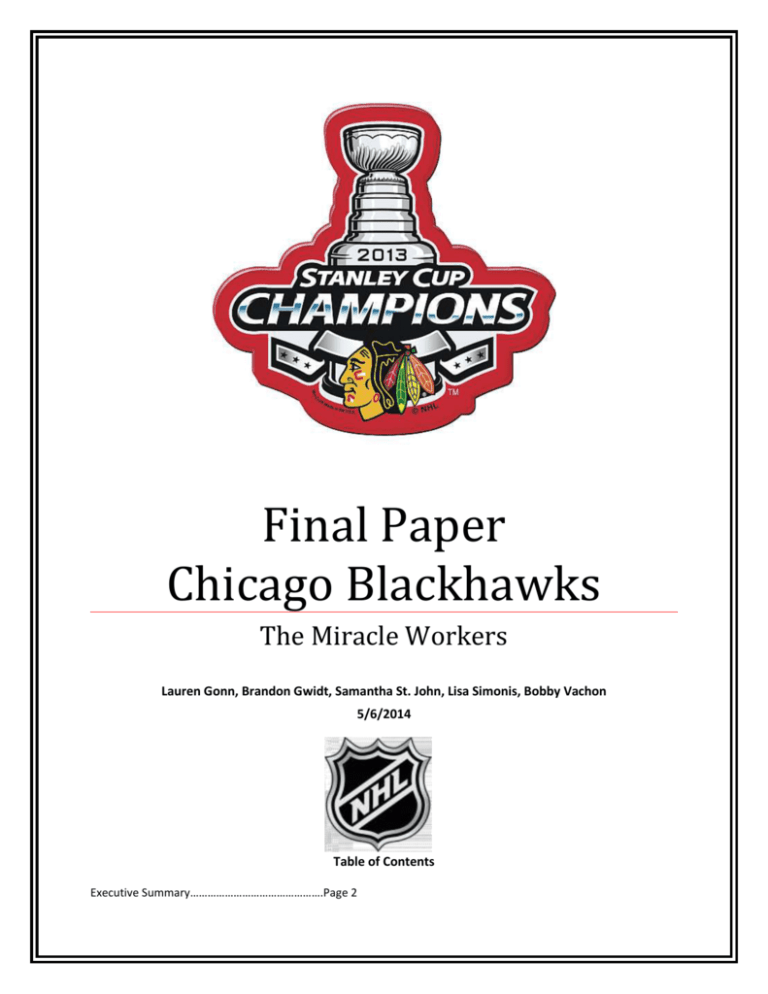
Final Paper Chicago Blackhawks The Miracle Workers Lauren Gonn, Brandon Gwidt, Samantha St. John, Lisa Simonis, Bobby Vachon 5/6/2014 Table of Contents Executive Summary……………………………………….Page 2 Introduction…………………………………………………..Page 3 Stakeholder Analysis………………………………………Page 4 Business and Communication Goals……………….Page 5 Key Messages…………………………………………………Page 7 Message Strategy…………………………………………..Page 8 Channel Strategy…………………………………………….Page 10 Process Strategy……………………………………………..Page 11 Rejected Solutions………………………………………...Page 13 Evaluation………………………………………………………Page 14 Continuous Improvements…………………………….Page 14 Adjustments…………………………………………………..Page 15 Conclusion……………………………………………………..Page 16 Appendix A: Crisis Facts……………………………………………………..Page 17 Works Cited……………………………………………………Page 19 This paper will describe and explain the strategies we came up with for our crisis that we were presented with. 1 Executive Summary Our case began with a series of clues largely triggered by recent news events. Our first clue involved the previous CEO of Mozilla Firefox, Brendan Eich, who was faced with homophobic publicity after a private donation was leaked to the press. From there, our clues escalated when our CEO was publicized making extremely offensive comments regarding the homosexual community. There were also links to Russian president, Vladimir Putin, in regard to his discriminatory policy toward homosexuals, and his comprised reputation as a world leader in general. In this regard, our clues were divided between discrimination issues, and national loyalty questions. The link between the two, we found, was Putin, and we decided to strategically severe that link for our press conference and discuss the more relevant issue, homosexual discrimination. By not acknowledging the Russian rumors, we were able to focus our attention to the legitimate and pressing issue, rather than get lost in irreverent rumors. Based on our Crisis Control procedures, we classified this event as individual misconduct. In this regard, the organization was going to experience a medium-high level of perceived responsibility by our stakeholders, so ultimately, we wanted to balance concern and control to regain the trust of our stakeholders. Since there were no victims, the issue was going to be reputation damage control. Our business goal was to protect our brand image, which drove our communication goals. We wanted to separate the CEO from the brand to reinsure the integrity and the values of the organization. These goals drove us to a strategy that combines corrective action, ingratiation, and an apology. For our press conference, we carefully disclosed limited details of the discriminatory actions. While staying apologetic, we emphasized the corrective action that we would take, which was a suspension and sensitivity training for our CEO, so that he could learn the importance of expressing himself in a respectful manner. We strategically emphasized political neutrality for the organization. Based on our audience analysis, we did not want to take political sides, rather emphasize respect and 2 tolerance of other opinions. Our stakeholders would have a range of political opinions, but most would agree that respect and tolerance are important standards of behavior. Our main message that we wanted the press to come away with was that the Chicago Blackhawks promote a policy of tolerance for political, social, and human differences. From there, we developed our meme, which was “Breaking the ICE.” ICE stands for International Concern for Equality, which indicates that we are facing a broad international battle, but with respect, tolerance, and an anti-discrimination policy, we are chipping away at a hard surface. If we keep the momentum going, by taking corrective measures in situations such as these, we can ultimately, break the ice, and create a climate where diversity is accepted and embraced. We used existing NHL policies to back up our claims and demonstrate control, as well as utilized a joint spokesperson approach to re-instill confidence. In order to effectively present this message, channeling was very important. We utilized a dualspokesperson channel choice. We had our PR representative, Lisa Simonis, address the issue with great concern, presenting the facts and introducing the message. However, from there we wanted to shift the attention to the future. By introducing our new leader, and proclaiming his pride, as well as his vision for the Blackhawks, we were able emphasize control and create a sense of pride in the brand, distracting from the negative issue and creating positive momentum. Following up the press conference, we emphasized careful monitoring to evaluate our strategy, but overall were confident in our ability to regain strength as an organization and emerge from this crisis with our brand intact. Introduction: Overall this case was a great challenge for our group because we have never been assigned to take action so quickly in our previous coursework, but we felt we were well prepared before the crisis so once it came we were able to refer to our crisis manual to help determine our strategies. By having a 3 plan in place, even though it did not directly address our specific crisis, we were able to avoid going in full panic mode because we had the necessary steps and procedures in place to handle any crisis that could potentially happen to the Chicago Blackhawks. Being fully prepared even if we do not know exactly what is coming is no doubt one of the most important lessons we learned from this case study. You can tell when organizations are prepared in the real-world because their decisions are calculated and many of the little things are already decided before a time of crisis. The most challenging part for us was piecing together different clues and information to decide what is most important to address and how to handle potential questions. Once we cleared up our information and decided the message strategy, we practiced our press conference over and over again. By practicing repeatedly and being prepared, Lisa and Brandon, who were the speakers, had what they wanted to say memorized and were able to communicate it as well as possible. Stakeholders Analysis: We had a large list of audiences in our crisis communication plan before our crisis so once we put together the clues we decided which audiences we needed to address directly and indirectly. The most difficult part was deciding which stakeholders were affected the most in this crisis. One of our clues mentioned the Donald Sterling crisis in the National Basketball Association so we looked into that case, even though it is still ongoing, and we decided our case was much different. The NBA is 80% African American and with the racial comments Mr. Sterling made it was taking a shot at your core audience. While homophobia is not accepted in the NHL, in our audience analysis we determined there are not any victims or groups of people directly affected. However, there are audiences to address with this crisis. The Chicago Blackhawks fans and season ticket holders are a primary stakeholder because they are what makes our product and organization what it is today. For 41 home games a season there are 4 22,000 people per game that attend Blackhawks games. In today’s society it is not appropriate to make the comments the Blackhawks CEO made and our fan base in a way represents society as a whole. The National Hockey League was another primary audience because while we are an individual organization, ultimately we are member of the NHL and are governed by their rules and board of governors. All 29 other owners would want an explanation on the words spoken by our CEO and owner. Corporate sponsors would need to be communicated to because it is likely many sponsors would want to either temporarily or permanently pull their sponsorship with the Blackhawks because they do not want their company associated with such negative remarks. It is important to get in contact with all corporate sponsors as quickly as possible and assure them that we are taking all the necessary steps to correct this issue and reinforce the idea that the opinions of a couple of individuals do not represent our organization. The media is also of great concern to the Chicago Blackhawks because ultimately they are the gatekeepers to controlling our message no matter if the publicity puts our organization in a good or bad light. The media is likely to gravitate towards controversy because that is what is newsworthy. A case like this is going to get coverage from more than just the sports world so when formulating our channel and message strategy we kept that in mind. The employees of the Chicago Blackhawks are a stakeholder as well because when higher-ups in the company share the beliefs and values such as the Blackhawks CEO and owner did, employees may not want to associate themselves with or work for an organization that has those values, which is a great concern. Business and Communication Goals: For our business and communication goals, one of our main business goals was the Blackhawks brand image. Since the Blackhawks organization was first adopted in 1926, their brand has remained strong and consistent. Their logo has never changed and continues to represent their team proudly. The Blackhawks brand is truly their greatest asset. Another goal we had was to reassure the stakeholders 5 that the Chicago Blackhawks had absolutely nothing to do with the anti-gay remarks. These remarks were CEO McDonough’s personal opinion only, and reflect a one-sided argument. We made sure that the Blackhawks emphasize that their team is open to people of all religions, political views, and values. Our last business goal we wanted to accomplish was to minimize all of our losses. We were presented with many obstacles and had to choose which ones to address, and which ones to sweep under the rug so to speak. Our main issue was dealing with the anti-gay remarks made by our CEO. So we wanted to focus primarily on this issue, and deal with any other questions relating to it in the press conference. Anything dealing with Russia and Putin we decided to either not answer, or answer very carefully to a certain extent. We had to think strategically through our plan, in order to gain trust, and the hope to continue the relationships with the Blackhawks sponsors and fans. Our communication goals focused on the Blackhawks organization beliefs and what they stand for. First, we wanted to separate our perpetrator from our offender. As stated with our brand image business goal, we wanted to show that the CEO’s opinion does not contribute to or affect the organization’s values. Second, we wanted to reinsure the integrity of the organization. We wanted to emphasize that the Chicago Blackhawks are politically neutral and accept everyone. No matter if they are gay, straight, bisexual, or transgender. Everyone on the team will be treated as equals, and will get the same opportunity to show what they can do out on the ice. Lastly, we wanted to emphasize the equal rights concern even further. Explaining the steps we are taking to take control of the situation, and how we will deal with these situations in the future. Also, to show great empathy towards those affected by the anti-gay remarks, and to let them know that the Blackhawks organization stands behind them. That anyone with the skills to play will be able to play without worry of discrimination. 6 Key Messages: Key messages were an important part in our strategy in dealing with the case given. There were a number massages that our group wanted to get out to the public so it was extremely important that we emphasized certain ones over others given the circumstances surrounding the case. The primary message that would be used during the press conference and throughout the rest of our campaign would be, “The Chicago Blackhawks Endorse Tolerance for Political, Social, and Human Differences.” This message is important in showing that the Chicago Blackhawks organization does not stand for any discrimination of any kind and focuses on being a tolerant organization no matter what nationality, political beliefs or sexual orientation one might have as a member of the Chicago Blackhawks. There were also secondary messages that our group had in addition to the primary message above. These messages were to show a change in the organization and to show the organizations commitments to overcoming the statements that the Chicago Blackhawks organization is intolerant to homosexuals. The first of these secondary messages is, “Creating a Better Tomorrow: Focus on community involvement.” This message along with the, “One Goal: Commitment and excellence on and off the ice” were created seven years ago when the management for the Blackhawks restructured. This was to let the community of Chicago know that there were major changes to the organization, a new focus on the team’s involvement within the community as well as on the ice. Both of which have been shown by the Blackhawks through their various community charities as well as other events where members of the Blackhawks help out in various events in the Chicago area. This has also been shown on ice, as in the past four years the Blackhawks have won two Stanley Cup titles. 7 The next message that our group wants to emphasize is the Blackhawks and the NHL’s partnership with the “You Can Play” program. This program was designed to help break down the barriers in sports between homosexual and straight players. The emphasis of this participation with the support of this group further shows the Chicago Blackhawk’s commitment to showing their tolerance of all groups in the NHL. Lastly, our group wants to again emphasize our MEME for this campaign which is “Breaking the ICE.” Ice stands for an International Concern for Equality and ties right into our opening message of The Chicago Blackhawks Endorse Tolerance for Political, Social, and Human Differences. The emphasis on equality to all regardless of political or social views is the key message which will be throughout our campaign. Message Strategy: Our message strategy was to avoid addressing the Russian clues altogether. Those clues were based on speculation, and as rumors, were rather irrelevant to the larger issues at hand. Addressing those rumors in the press conference meant legitimizing them, which we strategically avoided. The discriminatory comments were far more damaging to the brand, and needed careful messaging for the Blackhawks to recover. There were a number of words or points that we strategically decided to avoid, along with the Russian conspiracy theories. They included any discriminatory terms toward the gay community. We did not want to offend our stakeholders further, and specifically, we would avoid repeating the messaging of the video. We also wanted to avoid associating ourselves with negative news figures such as Brendan Eich or Vladimir Putin. These names trigger negative connotations and we did want to be linked with them if we could avoid it. Instead, we wanted to repeatedly mention equality, individual freedoms, tolerance, and the strength of the Blackhawk brand. 8 Based on our audience analysis, we determined that our stakeholders were going to have a wide range of political and social opinions. After Brendan Eich stepped down as CEO, Mozilla Firefox experience a lot of backlash for the organization’s intolerance for his political opinions. We wanted to avoid this type of turning situation by establishing the Blackhawks as politically neutral and to separate the opinions of individuals from the brand. Instead, we chose to emphasize a policy of tolerance and respect toward diversity, whether it be racial, sexual orientation, or political. We did this by emphasizing existing policies of the NHL, but acknowledging that just because policies are in place, the battle is not yet won. This event proved that there would be hiccups with the implementation of the existing antidiscrimination policy. Because of these issues, we developed a meme to express the Blackhawks desire to create a favorable environment for diversity to prosper. “Breaking the ICE: International Concern for Equality,” is a meme that unpacks to this: We are facing a broad discrimination problem in the sports sector that extends internationally. By acknowledging and correctly handling violating acts, such as the one that we are currently addressing, we are chipping away at the surface, with the ultimate goal of breaking the ice, to create an environment where diversity is accepted and embraced. Overall the first component of our messaging strategy was to demonstrate concern, but to emerge with confidence and control. Our secondary goal was to re-establish goodwill for the organization through ingratiation. To do this, we borrowed previous messaging of the Chicago Blackhawks including “One Goal,” which is a commitment to excellence. We wanted to emphasize pride in our brand and in players, despite the poor choices of management figures. Within our press conference, the introduction of our new CEO was vital to help re-establish Blackhawk pride, and demonstrate control among chaos. 9 Channel Strategy: When formulating our channel strategy we looked deep into our audience analysis and core messages to decide how we would be able to most effectively communicate our message. The first thing we decided was to have the CEO write a written apology about the comments he made about homosexuals and the roster of the Chicago Blackhawks. We felt this was the best thing to do as a corrective action right away because we did not want to make the CEO vulnerable and put his face out there for criticism. The words he already spoke are getting publicity enough. The written apology does not go into much detail but will show the Blackhawks stakeholders that he is remorseful. This is a low risk tactic because he is not going to face questions which is good since there is probably a very hostile attitude towards him. This statement will likely become part of the story for the media as they will read the details about the crisis and then afterwards show the apology the CEO wrote. The press conference was the biggest point of emphasis for us because this is where we had to address our audiences and any concerns they have. We received many clues about our crisis and we initially had a hard time identifying what exactly our crisis was. Our CEO had ties with Russian president Vladimir Putin, a strong relationship with Brendan Eich, former CEO of Mozilla Firefox, and a contribution to Proposition 8. We strategically decided to ignore these tidbits directly because they had low value compared to the anti-gay remarks and team roster decisions that the CEO commented on. We knew there were going to be questions about the Russian relations, and we planned for them, but to bring them up on our own would have shown a weakness. After suspending the CEO we introduced the interim CEO who would be serving while the current CEO is suspended. He could then go into detail about the values of the Chicago Blackhawks and bring up the great organization they are and the history they have. Once the interim CEO spoke the thought was that listeners would almost forget for a moment about the exact issue. 10 Before the CEO would be able to return from suspension we would have him do a sit-down interview with notable NHL analyst Kevin Weekes that would be pre-recorded. By having this interview roughly eight months after the crisis it will not be front page material but will still be able to get our message out to our stakeholders and show that the corrective action we took was successful. Ideally it would also recreate some goodwill and forgiveness with the CEO moving forward. It’s also important to keep in mind the comments the owner of the Blackhawks made and the role he played in this regrettable situation. However, as an organization, there is not much we can do to punish the owner or separate the organization from him. The NHL will take control in an instance like this and hand out the appropriate punishments they deem necessary. In our statements and press conference we apologize and express regret for the owner’s comments. Also, we clearly state that the NHL is reviewing the situation and our Owner and CEO will accept any punishment the NHL hands down to them. Process Strategy: Our crisis communication can be divided into three main time periods: before, during, and after our press conference. These three time periods were critical in the resolve of our crisis, and it was important to order our communications in a sensible way, and handling the situation with urgency. Before the implementation of our press conference, we had to analyze our crisis alongside the facts and information about our organization. In this process, newsbreaks, stories, leaks, and rumors were pieced together to form our "big-picture". Communication between our players, staff, and CEO would also be implemented immediately, to confirm or null the validity of the crisis. The first step is communicating with, and convincing upper management that the issue at hand is a crisis. To follow immediately after gaining an understanding of the issue, we found it important to 11 address it publicly as soon as possible. The offending CEO McDonough is to deliver a public written statement to be released by the Blackhawks. This statement would express an acknowledgement to the inappropriate nature of his actions and an acceptance of any consequences to be deemed necessary by the organization's administration or the National Hockey League. This statement would be released to major stakeholders and sponsors and the ESPN network, which had requested a statement as the crisis developed. This decision is meant to prepare stakeholders and keep them informed, while building upon goodwill with the reputable ESPN sports network. The press conference is an opportunity to officially address the crisis to the public. Sports networks and various news media would be in attendance to witness our delivery of our messages. The message strategies are applied at this time, to help us express concern for the issue and control of the situation. Our meme is meant to resonate with the media, and eventually, their audiences. The introduction of our interim CEO was a choice that drew attention away from the crisis, without seeming like the issue was being swept under the rug. Our goal was to respond with corrective actions and move forward as soon as possible. After the press conference, CEO McDonough's suspension would be effective immediately. To follow, an official interview would be released around the same time or before news stories from the conference would be published. This process would allow our fans, stakeholders, and employees all have the same information and conclusion available to them. A continuation of the ideas and practices mentioned would be the most important aspect of our process. The entire crisis management process would be irrelevant if the Blackhawks failed to follow through and uphold the increased practices of tolerance and support of alternative lifestyles and viewpoints. This crisis became an opportunity for change, and the Blackhawks are given the chance to be a leader in the tolerance and acceptance of homosexuality in the NHL. 12 To parallel our meme, the ice is broken, and it's time for change. Rejected Solutions Within our process, we thought of a few ways to handle our crisis, and we're able to narrow down our options to what we found to be the most effective. Our rejected solutions were as follows: 1. Firing CEO McDonough Rationale: as we found with the outcome of Brendan Eich, the former CEO of Mozilla, firing someone for their personal opinion can turn out to have further effects and consequences than keeping them. Just as there are people who disagree with the offending point-of-view, there are those who agree and have the capability of effecting the organization. Regardless of which view is "correct", people have the freedom to possess either opinion and shouldn't be discriminated for those ideas. 2. Acknowledging all rumors and possible accusations Rationale: If we had taken time to acknowledge every piece of information thrown at us, it would have proved to be an ineffective use of our time, and result in a cluttered message. There were rumors and pieces of information that held very little weight in the scheme of the entire crisis. 3. Aligning and associating strongly with a single point of view Rationale: in order to separate our organization from the discriminatory and negative ideas and viewpoints, we found it important to emphasize neutrality instead of sending out a strong message from the other side of the spectrum. Our goal is to promote acceptance of others and a tolerance of differing opinions among individuals, and emphasizing that the organization itself does not align either way. 13 Individuals are free to have any idea or opinion, but in no way should it be associated with their professional persona, if it can affect the organization as a whole. Evaluation Tactics: The overall crisis plan’s success will be evaluated on a number of tactics. The first evaluation tactic will be the analysis of the Chicago Blackhawks’ corporate sponsors. If any sponsors have pulled out due to the implications of the crisis then our plan will have been considered a failure. Evaluation of relationships with our stakeholders will be the second evaluation tactic. Maintaining strong relationships with the Blackhawks stakeholders is extremely important to the organization and any stakeholders that pull out because of the incident would be regarded as a failure. There are two more areas on which the success of the campaign will be evaluated. The first of these will be evaluating ticket sales. The Chicago Blackhawks have had the largest attendance in the NHL for the past six years and they are extremely proud of that fact. The fans are what make the Chicago Blackhawks the great organization that it is and to not have the number one attendance in the NHL because of this incident would be regarded as a failure. The second part to this would the evaluating the organization’s annual earnings. As with the ticket sales, if there were to be a significant decrease to the organization’s annual earnings, the plan would be regarded as a failure. Continuous Improvement: Since our first presentation, our group has shown improvements in preparing and presenting our second case study. We were able to have multiple meeting times that worked for everyone, and had productive discussions during. Our communication in general with one another has changed as we got to know each other better. However, communicating is a process and can always be improved; everyone 14 has different personalities and experiences to share. Learning to adapt and understand these things is very important when communicating with one another. After going through the whole process of our second case study and then presenting it, we still continue to learn from each other and those around us. As well as the techniques we used to apply the information in our presentation. This second case was more of a challenge with having to deal with a press conference setting. Going forward we need to get better at answering questions on the spot. Knowing the right words to say and actions to take is definitely a challenge. This was a great experience and opened the door for more possibilities with our communicating abilities. Overall we will continue to learn how to communicate with others in a group setting. We will also improve our speaking abilities when presenting in front of people. Practice makes perfect and confidence while speaking is something we can definitely improve on. Post Training Adjustments to Crisis Control Plan: We followed the structure of our crisis control plan fairly intently, but were still left with a large job after receiving the crisis. While our plan was a beneficial aide, we did see ways to better its value. After the crisis simulation, we have gathered new insights that will help us better prepare in the future. The most valuable thing that we learned was not to be too specific. Both in this stimulation, and in real life, it is difficult to anticipate directions that crises will take, so it is important to maintain a sense of flexibility. In our plan, we developed a series of messages that we felt would be appropriate to use in any crisis. This may have been slightly premature. By having existing messages in the plan, we were more susceptible to generic messaging. As support, for the purposes of ingratiation, the messages were helpful. However, ingratiation was not our most prevalent strategy. In this way, the messages were good underlining themes, but we couldn’t over-utilize them. We needed to develop a unique message to fit 15 the situation, as well as an unpackable meme to get the message across. While we did do this, striking the correct balance of these messages were difficult, as we had to be sure that crisis specific messaging prevailed, and our messaging didn’t sound generic and careless. Part of our plan that could actually be more detailed was audience analysis. Understanding the demographics and psycho-demographics of our different stakeholders would be valuable information in any crisis. While we did this to some extent, in this area, more detail is better. We can always strive to better understand our stakeholders so we can more easily detect and address their concerns as new crises emerge. Finally, although we realized that a combination of strategies was necessary to approach any crisis group, we could have prioritized these strategies according what should prevail and what should be underlying. Out of the 5Cs, which were most important within the different situations? By doing this, it could help us achieve the proper balance of an effective press conference, and drive our strategy in a more methodical way. Conclusion: As a group we all agreed this was the toughest and most challenging case we have ever done in our coursework, but we also thought it felt like a real-life situation. We developed as a group over the semester and we were able to learn each other’s strengths and weaknesses to help use them to the group’s benefit. The Chicago Blackhawks were a great organization for us to do because we all had some familiarity with the organization which really helped during the preliminary research. The most stressful part of the case was on Sunday afternoon when we started to receive clues on our crisis. We were not all together at the time which made it even more difficult, but once we got together in-person we were able to take a deep breath and analyze our problem. Preparation was the common theme for us in this case because we developed the crisis manual days before we received our crisis and we practiced many 16 times before we presented so once the stressful times came we were well prepared and felt less stressed. There were definitely some minor mistakes we made throughout the process, mainly with our messaging, but overall as a group we felt we were successful in handling the situation and upholding the reputation of the Chicago Blackhawks. FACTS: COMM CRISIS RESEARCH Donald Sterling Donald Sterling’s private conversation with his mistress was leaked by an anonymous source. Sterling is the owner of the Los Angeles Clippers (MBA). Sterling’s players demonstrated protest by wearing their jerseys inside out during their game, demonstrating disgrace for their name/owner. After comments were leaked, most/all of Clippers sponsors pulled out. The comments that Sterling made were extremely derogatory toward African Americans, specifically expressing distaste for Sterling’ s mistress to bring African Americans to his games. Sterling’s wife of 50 years is currently suing his mistress for property given to her over the course of their relationship. Sterling’s mistress is of mixed race, with both African and Caucasian descent. Vladimir Putin Vladimir Putin is the current President of Russian. Throughout his presidency, Putin has been a controversial leader, specifically regarding his political policies toward homosexuals. In 2013, Vladimir Putin signed an anti-gay propaganda bill (which was referred to in our case). Putin also signed a bill imposing jail terms and fines for those who “offend religious believers” after an anti-Putin stunt by a punk rock called Pussy Riot in the Moscow Cathedral. In response to the Olympics, Putin insisted the homosexuals would face no discrimination as long as the observed anti-propaganda laws and “stay away from children.” Putin’s quote: o “We do not have a ban on non-traditional sexual relationships…We have a ban or propaganda of homosexual and pedophilia. I want to underline this. Propaganda among children. These are absolutely different things- a ban on the propaganda of that thing.” Brendan Eich Brendan Eich was the CEO for Mozilla Firefox for less than two weeks. He was encouraged to step down after it was discovered that he made a $1000 donation to Proposition 8. Proposition 8 is informally known as Prop 8. 17 It is a California ballot proposition and state constitutional amendment passed in November 2008 California state elections. Proposition 8 aims to define marriage between a man and a woman (Anti-Gay Marriage). The donation was made public after the confidential list of donors were leaked by a group of hackers. Mozilla Firefox faced a boycott after gaining a reputation as an anit-gay organization. However, MF experienced further backlash after Eich stepped down, as tensions emerged between the Eich’s rights of political freedom, versus discrimination issues. Does MR have the right to discriminate against Eich for his political beliefs? TMZ: A celebrity gossip news source. Many news stories (such as Sterling’s case) began on TMZ before erupting to other networks. The Americans: The Americans is a Russian Spy themed television program. It was created by former CIA agent Joe Weiseberg. The series premiered in the US Jan 30, 2013. Set in the Cold War Period in the 1980s 1812 Overachure: An overture written in 1880 to commemorate Russians defense against Napoleons invading Grand Armee in 1812. Often used during firework ceremonies, including in USA celebrations. It has no connection with 1812 war between USA and Britian. Debuted in Moscow August 20, 1882. NHL You Can Play Project which is Gay Athletes, Straight Allies, Teaming Up For Respect. Article 7.2 of the NHL collective bargaining agreement states that any personnel shall not discriminate based on religion, race, disability and sexual orientation. Many players spoke out against Russia’s anti-gay laws. Gary Bettman had a sit down interview to talk about gay athletes. NHL is considered most diverse sport of the four North American Sports. Works Cited: http://blackhawks.nhl.com/v2/ext/CR%20booklet/2011-12%20Community%20Report.pdf http://blackhawks.nhl.com/v2/ext/CR%20booklet/CR-Report-2012-13.pdf http://www.forbes.com/teams/chicago-blackhawks/ 18 http://www.wandtv.com/ http://www.wics.com/ http://www.wifr.com/home http://www.cityofchicago.org/city/en/depts/cfd.html http://blackhawks.nhl.com/club/page.htm?id=47399 http://www.celebritynetworth.com/richest-businessmen/ceos/rocky-wirtz-net-worth/ http://blogs.longwood.edu/martapinyoldavi/files/2013/02/Crisis-Communication-Plan.pdf http://www.uwgb.edu/clampitp/Phils%20Site/Internet_Broadcast/caseshome.htm http://www.thehockeynews.com/ http://www.outsports.com/2014/1/17/5320554/gary-bettman-gay-nhl-tsn http://www.theguardian.com/world/vladimir-putin 19
